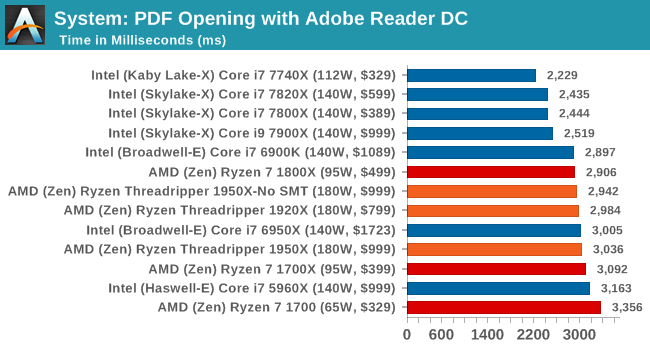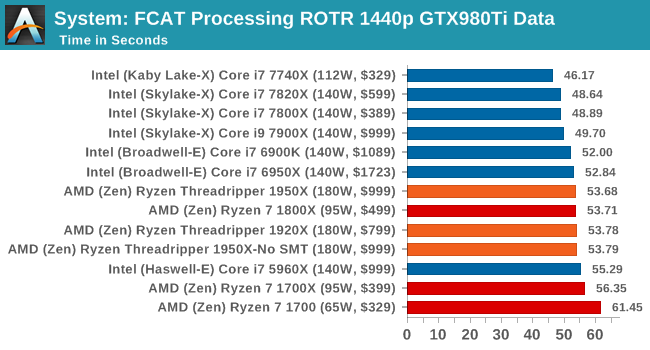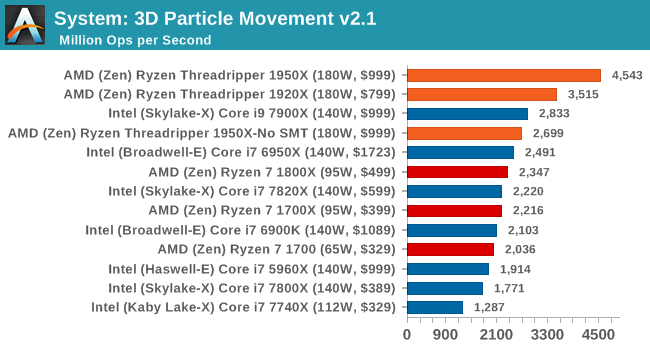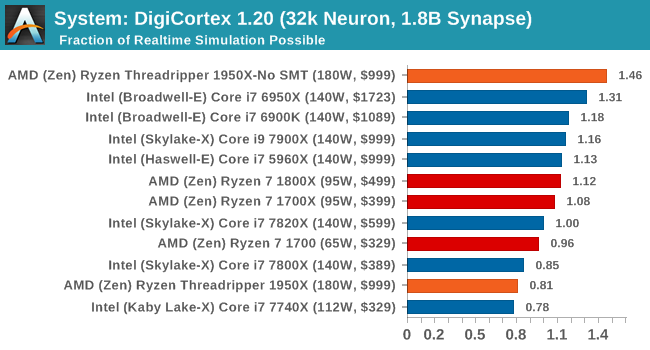The AMD Ryzen Threadripper 1950X and 1920X Review: CPUs on Steroids
by Ian Cutress on August 10, 2017 9:00 AM ESTCPU System Tests
Our first set of tests is our general system tests. These set of tests are meant to emulate more about what people usually do on a system, like opening large files or processing small stacks of data. This is a bit different to our office testing, which uses more industry standard benchmarks, and a few of the benchmarks here are relatively new and different.
All of our benchmark results can also be found in our benchmark engine, Bench.
PDF Opening
First up is a self-penned test using a monstrous PDF we once received in advance of attending an event. While the PDF was only a single page, it had so many high-quality layers embedded it was taking north of 15 seconds to open and to gain control on the mid-range notebook I was using at the time. This put it as a great candidate for our 'let's open an obnoxious PDF' test. Here we use Adobe Reader DC, and disable all the update functionality within. The benchmark sets the screen to 1080p, opens the PDF to in fit-to-screen mode, and measures the time from sending the command to open the PDF until it is fully displayed and the user can take control of the software again. The test is repeated ten times, and the average time taken. Results are in milliseconds.

This opening test is single threaded, so the high-frequency Intel parts get a clear win. There's not much between the Threadripper CPUs here.
FCAT Processing: link
One of the more interesting workloads that has crossed our desks in recent quarters is FCAT - the tool we use to measure and visually analyze stuttering in gaming due to dropped or runt frames. The FCAT process requires enabling a color-based overlay onto a game, recording the gameplay, and then parsing the video file through the analysis software. The software is mostly single-threaded, however because the video is basically in a raw format, the file size is large and requires moving a lot of data around. For our test, we take a 90-second clip of the Rise of the Tomb Raider benchmark running on a GTX 980 Ti at 1440p, which comes in around 21 GB, and measure the time it takes to process through the visual analysis tool.

Similar to PDF opening, single threaded performance wins out.
Dolphin Benchmark: link
Many emulators are often bound by single thread CPU performance, and general reports tended to suggest that Haswell provided a significant boost to emulator performance. This benchmark runs a Wii program that ray traces a complex 3D scene inside the Dolphin Wii emulator. Performance on this benchmark is a good proxy of the speed of Dolphin CPU emulation, which is an intensive single core task using most aspects of a CPU. Results are given in minutes, where the Wii itself scores 17.53 minutes.

Dolphin likes single thread performance as well, although having some cores to back it up seems to be required.
3D Movement Algorithm Test v2.1: link
This is the latest version of the self-penned 3DPM benchmark. The goal of 3DPM is to simulate semi-optimized scientific algorithms taken directly from my doctorate thesis. Version 2.1 improves over 2.0 by passing the main particle structs by reference rather than by value, and decreasing the amount of double->float->double recasts the compiler was adding in. It affords a ~25% speed-up over v2.0, which means new data.

Our first pure multithreaded test, and the 1950X wins with 32 threads. The 1920X beats the 1950X in SMT-off mode, due to 24 threads beating 16 threads.
DigiCortex v1.20: link
Despite being a couple of years old, the DigiCortex software is a pet project for the visualization of neuron and synapse activity in the brain. The software comes with a variety of benchmark modes, and we take the small benchmark which runs a 32k neuron/1.8B synapse simulation. The results on the output are given as a fraction of whether the system can simulate in real-time, so anything above a value of one is suitable for real-time work. The benchmark offers a 'no firing synapse' mode, which in essence detects DRAM and bus speed, however we take the firing mode which adds CPU work with every firing.

DigiCortex requires a mash of CPU frequency and DRAM performance to get a good result, and anything with quad-channel memory is usually preferred. The 1950X in SMT-off mode wins here due to its low main memory latency combined with having 16 threads to access it. The Broadwell-E is the nearest competitor, over Skylake-X, most likely due to the mesh vs ring topology. The 1950X in Creator mode scores way down the field however, lower than the standard Ryzen chips, showing that under a unified memory architecture there can be significant performance drops. The 1920X failed in this test for an unknown reason.
Agisoft Photoscan 1.0: link
Photoscan stays in our benchmark suite from the previous version, however now we are running on Windows 10 so features such as Speed Shift on the latest processors come into play. The concept of Photoscan is translating many 2D images into a 3D model - so the more detailed the images, and the more you have, the better the model. The algorithm has four stages, some single threaded and some multi-threaded, along with some cache/memory dependency in there as well. For some of the more variable threaded workload, features such as Speed Shift and XFR will be able to take advantage of CPU stalls or downtime, giving sizeable speedups on newer microarchitectures.

The variable threaded nature of Agisoft shows that in our workflow, it's a mix of cores, IPC and frequency required to win. AMD takes a back seat here, likely due to its AVX implementation.










347 Comments
View All Comments
Pekish79 - Friday, August 11, 2017 - link
Vraybench 1.0.5SanX - Friday, August 11, 2017 - link
*** AMD, make 2-chip mobos for upcoming multicore wars, you will double your profit from this at no cost for you +++vicbee - Friday, August 11, 2017 - link
Off subject: Having just read the article about nVidia's meteoric rise in profits, some of which directly attributed to high end "gamers" video cards purchased expressly for coin mining, I wonder if it and AMD are going to manufacture CPU's and GPU's specifically for that purpose and how that will affect the price of said parts...Avro Arrow - Friday, August 11, 2017 - link
Hi Ian, thanks for doing this article. It's important to see all possible outcomes because in the real world, anything is possible. I do have one question that has be puzzled. Why do you say that Threadripper only has 64 PCI-Express 3.0 lanes when it's been reported several times by everyone, including official AMD releases (and also including by you) that it has 64? I thought it might be just a typo but you state it in several places and in all of your specs. This is not a new thing so is there something about Threadripper that we don't know?HotJob - Friday, August 11, 2017 - link
Could someone explain to me what a "2P" system is from the competition section of the article?coolhardware - Saturday, August 12, 2017 - link
"2P" system = two processor system, i.e. a system with two physical CPU sockets and two CPUs installed.In the past a 2P (or 4P) system was really handy to get more cores especially back when 1 core, 2 core, and eventually 4 core CPUs were high end. In the consumer realm, way back, the Pentium II was the first 2P system I ever built and people even did it with Celerons as well:
http://www.cpu-central.com/dualceleron/
the Opterons were also fun for dual or quad processor systems including some SFF options like the ZMAX-DP socket 940 system.
https://www.newegg.com/Product/Product.aspx?Item=N...
Now fast forward with ThreadRipper already available at Amazon and NewEgg
http://amzn.to/2wDqgWw (URL shortened)
https://www.newegg.com/Product/Product.aspx?Item=N...
I do not think I will ever be building a 2P or 4P system again!!!
:-)
rvborgh - Friday, August 11, 2017 - link
hi Ian,i think the Cinebench 11.5 benchmarks are incorrect for both ThreadRippers. ThreadRipper is almost equivalent to my Quad Opteron (48 core) system which scores 3229cb on R15... and 39.04 on Cinebench 11.5. if i downclock all cores to approximately 2.9 GHz i end up with around 3000cb in R15 and in the 36 range point range for 11.5.
The fact that you are only scoring in the 18 range makes me wonder if you had the Threadripper set in some mode where it was only using 8 out of the 16 cores. Can you verify this... please? Thanks :) i would think you should see scores in the 36 range with 11.5.
Other than this minor detail... great article.
PS: i've had the same issues with software not liking NUMA on my quad opteron system as well... Cinebench especially does not like it.
Tchamber - Saturday, August 12, 2017 - link
Hi, Ian. Thanks for the review. As usual it was in depth and informative. I'm in the middle of building a 1700x system now based on your review. I wanted to say you handle all the nay-Sayers, gloomy Gusses and negative Nacies with aplomb! I think most people's own slant colors how they see your reviews. I appreciate the consistency of what you do here. I took a look over at Ars, and they could be called AMD shills for all the positive things they say... Keep it up!Tchamber - Saturday, August 12, 2017 - link
P.S.I loved your Kessel Run reference, it tied in nicely with your Yoda quote.
B3an - Saturday, August 12, 2017 - link
Too many plebs complaining about a lack of 3D rendering benches. The fact is a 16 core CPU is still much slower than GPU's at rendering. I'll be getting a 1950X but it wont even be used for rendering when i know for a fact that my two GPUs will still be much faster with things like Blender. Even a single high-end GPU will still easily beat the 1950X at these tasks.Seems like immature moron fanboys are crying over this stuff because they just want to see AMD at the top of the charts.